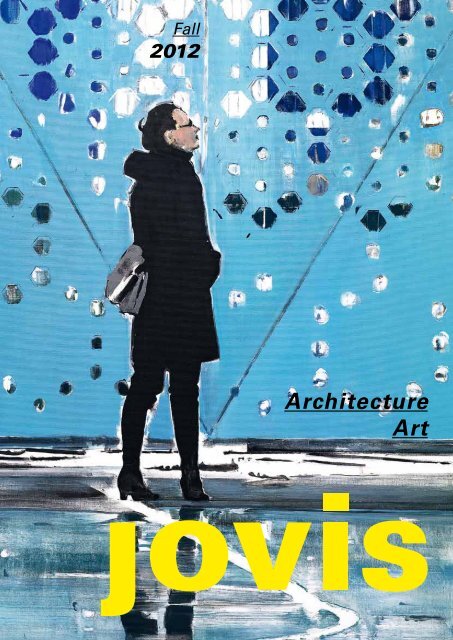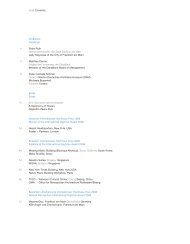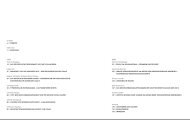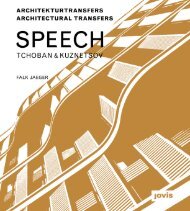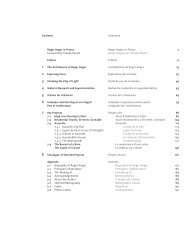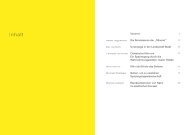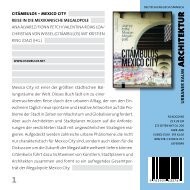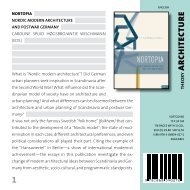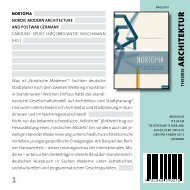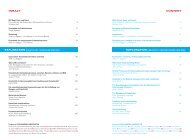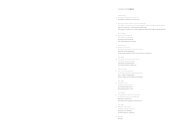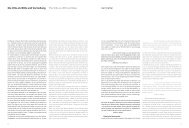Architecture Art
Architecture Art
Architecture Art
You also want an ePaper? Increase the reach of your titles
YUMPU automatically turns print PDFs into web optimized ePapers that Google loves.
Fall<br />
2012<br />
<strong>Architecture</strong><br />
<strong>Art</strong>
Cover:<br />
Koen Vermeule: Dome, 2008<br />
210 x 200 cm, oil and acrylic on canvas (detail)<br />
All illustrations originate from the respective publications. The copyright lies with the owners of the picture rights.
WERTE.<br />
Begründungen der<br />
Denkmalpflege in<br />
Geschichte und Gegenwart<br />
Hans-Rudolf Meier/Ingrid Scheurmann/<br />
Wolfgang Sonne/Ulrike Wendland (eds.)<br />
Hardcover<br />
19.5 x 24 cm<br />
288 pages witH approx. 40 col.<br />
and 160 b/w<br />
eUr (d) 38.00 sFr 52.00<br />
isbn 978-3-86859-162-0<br />
october 2012<br />
www.jovis.de<br />
Ever since the debates around 1900, led by protagonists<br />
such as Georg Dehio, Alois Riegl, Paul<br />
Clemen, and others, modern monument preservation<br />
has been regarded as a value-based applied<br />
historical science. Since that time, monument<br />
preservation theory has been shaped by<br />
the search for objectifiable criteria that can be<br />
applied to the valuation and rating of traditional<br />
architectural structures and the assessment of<br />
their practical effectiveness as cultural monuments.<br />
The articles in this volume trace the<br />
theory of valuation from a historical perspective<br />
and present an overview of current issues and<br />
problems. The book presents aspects of monument<br />
preservation in relation to urban planning,<br />
as well as debates about recent issues concerning<br />
iconography and cultures of remembrance<br />
and how they affect monument preservation.<br />
<strong>Architecture</strong> Houses<br />
German<br />
In addition, there are summaries of the history<br />
of terminology and of the development of the<br />
theory behind selected historical valuations.<br />
The publication resulted from the research<br />
project “Denkmal – Werte – Dialog. Historischkritische<br />
Analyse und systematisch-praktische<br />
Konzeption denkmalpflegerischer Leitwerte“,<br />
sponsored by the Federal Ministry of Education<br />
and Research.<br />
With contributions by: Arnold Bartetzky, Anke<br />
Binnewerg, Bernd Euler-Rolle, Dominique<br />
Fliegler, Silke Haps, Hans-Rudolf Meier,<br />
Matthias Noell, Birte Pusback, Ingrid Scheurmann,<br />
Wolfgang Sonne, Susanne Thiele,<br />
Johannes Warda, Stephanie Warnke-De Nobili<br />
and Ulrike Wendland.<br />
1
<strong>Architecture</strong> urban space <strong>Architecture</strong> urban space<br />
SEcond Hand<br />
SpacES<br />
Recycling Sites Under going<br />
Urban Transformation<br />
Michael Ziehl, Sarah Oßwald, Oliver<br />
Hasemann, Daniel Schnier<br />
soFtcover<br />
17 x 22 cm<br />
432 pages witH ca. 350 col.<br />
eUr (d) 29.95 sFr 40.00<br />
isbn 978-3-86859-155-2<br />
JUne 2012<br />
At vacant sites, second hand spaces draw on<br />
the atmosphere, the traces, the remains, and<br />
the history of their previous uses. Their actors<br />
develop an individual aesthetic out of the<br />
site that stands out due to its simplicity and<br />
improvised quality. New ideas are tested, and<br />
elements of surprise are created in the city.<br />
Second hand spaces evolve against the background<br />
of different demands on urban spaces<br />
and provide opportunities for interaction, par-<br />
enGlisH/German<br />
E-book<br />
Second Hand SpaceS<br />
Recycling SiteS UndeRgoing<br />
URban tRanSfoRmation<br />
micHael ZieHl, saraH osswald,<br />
oliver Hasemann, daniel scHnier<br />
epUb, 432 pages witH ca. 350 col.<br />
eUr (d) 21.99 sFr 29.70<br />
isbn 978-3-86859-908-4<br />
JUly 2012<br />
ticipation, and start-ups. They open up new<br />
courses of action for urban planning and at the<br />
same time make a contribution to the sustainable<br />
design of urban change.<br />
In nine essays, twenty-seven experts highlight<br />
the backgrounds, actors, and effects of second<br />
hand spaces based on fifteen projects from<br />
Europe, resulting in thematic links to current<br />
social discourses throughout the book.<br />
2 www.jovis.de www.jovis.de<br />
3
<strong>Architecture</strong> urban space<br />
UnGEWÖHnLIcH<br />
WoHnEn!<br />
Bremer Perspektiven<br />
Dirk Meyhöfer<br />
Edited by Bremer Zentrum<br />
für Baukultur (BZB)<br />
Hardcover<br />
16.8 x 24 cm<br />
160 pages witH ca. 100 col.<br />
eUr (d) 24.80 sFr 32.80<br />
isbn 978-3-86859-158-3<br />
JUly 2012<br />
What challenges does urban residential building<br />
face today? How can cities adapt to changing<br />
demographic, economic and ecologic<br />
circumstances, as well as to the new requirements<br />
of future residents? What is currently<br />
considered as exemplary residential building?<br />
These were the questions posed by the<br />
“Ungewöhnlich Wohnen!” (“Unusual Living”)<br />
contest, held by the city of Bremen in 2011.<br />
It sought proposals for five housing developments<br />
from the nineteen-fifties and nineteensixties.<br />
The objective was to amalgamate hybrid<br />
usages, such as living and working etc.,<br />
integrating them into the city and society.<br />
German<br />
The city was also to be made more attractive<br />
for newcomers.<br />
This book provides detailed documentation of<br />
the five winning designs by Spengler-Wiescholek<br />
(Hamburg), Arno Brandlhuber, Finn Geipel,<br />
BarArchitekten (all from Berlin) and Kempe Thill<br />
(Rotterdam). These exemplary models of qualitative,<br />
sustainable and achievable residential<br />
buildings are complemented by twenty further<br />
projects in Bremen, whose standards and aspirations<br />
are on a par with the award-winning<br />
designs.<br />
4 www.jovis.de<br />
LEbEn // GESTaLTEn<br />
In Zeiten endloser Krisen<br />
Deutscher Werkbund<br />
Hessen (ed.)<br />
soFtcover<br />
17 x 24 cm<br />
224 pages<br />
eUr (d) 29.80 sFr 42.00<br />
isbn 978-3-86859-156-9<br />
october 2012<br />
www.jovis.de<br />
Under what cultural conditions is qualitative<br />
design possible at the beginning of the twenty-first<br />
century? What concrete impact does<br />
successful design have?<br />
The answers to these questions are to be<br />
found less in the objects themselves than in<br />
the people who use these objects and are<br />
defined by their use. This book considers<br />
the cultural environment in which designing<br />
takes place, as well as its impact on people’s<br />
<strong>Architecture</strong> Tendencies<br />
German<br />
lives. Successful design is understood as responsible<br />
design and therefore has ethical<br />
connotations, because design as long-term<br />
action sets standards that it has to adhere to.<br />
The contributions to the book are based<br />
largely on the presentations made at the<br />
Werkbund conference in September 2011<br />
(German Work Federation of Architects, <strong>Art</strong>ists<br />
and Builders), held at Goethe University<br />
in Frankfurt/Main.<br />
5
<strong>Architecture</strong> landscape<br />
WIndEnERGIE Und<br />
LandScHafTSäSTHETIk<br />
Zur landschaftsgerechten<br />
Anordnung von<br />
Windfarmen<br />
Sören Schöbel<br />
soFtcover<br />
16.5 x 24 cm<br />
160 pages<br />
witH approx. 100 col.<br />
eUr (d) 24.80 sFr 32.80<br />
isbn 978-3-86859-150-7<br />
available<br />
alSo available:<br />
WateR SenSitive<br />
URban deSign<br />
iSbn 978-3-86859-106-4<br />
As a result of the energy transition brought<br />
about by the nuclear reactor disaster in Fukushima,<br />
the number of wind energy plants<br />
in Germany will increase further significantly.<br />
Already now they are a prominent feature of<br />
the landscape in many places. The plants are<br />
not undisputed: ecologically they undoubtedly<br />
make sense, but their conspicuous presence<br />
in the landscape is also vehemently contested.<br />
This book considers the question of how<br />
wind energy plants can be integrated appropriately<br />
and aesthetically into the landscape<br />
German<br />
and provides concrete suggestions for solutions<br />
regarding the positioning and layout of<br />
the masts. For the first time the wind energy<br />
plants are viewed not in isolation, but in relation<br />
to a comprehensive landscape aesthetic. What<br />
qualifies as a beautiful landscape nowadays?<br />
Which natural, cultural, historical, and contemporary<br />
elements, structures, and significances<br />
is it composed of? And how can wind energy<br />
plants be integrated into this?<br />
6 www.jovis.de<br />
bUILdInG THE<br />
fUTURE<br />
Maßstäbe des<br />
nachhaltigen Bauens<br />
Hans Drexler, Adeline Seidel (eds.)<br />
soFtcover<br />
14 x 19 cm<br />
approx. 316 pages witH nUmeroUs<br />
b/w and 50 postcards<br />
eUr (d) 28.00 sFr 38.00<br />
isbn 978-3-86859-166-8<br />
october 2012<br />
www.jovis.de<br />
Sustainable planning and building have become<br />
a key issue in architecture. Climate<br />
change, resource depletion and economic crises<br />
are also increasingly forcing architects and<br />
planners to question traditional methods and<br />
solutions. In recent years, research institutions<br />
and universities, as well as architecture and<br />
engineering companies, have started to seek<br />
new concepts for the implementation of sustainable<br />
architecture and urban development.<br />
Münster School of <strong>Architecture</strong> held a series<br />
of symposia in summer 2011, in which these<br />
topics were debated extensively with international<br />
experts. Building the Future provides a<br />
summary of the scope and significance of current<br />
concepts. The aim is to present a compre-<br />
<strong>Architecture</strong> Tendencies<br />
German, parTly enGlisH<br />
hensive overview of approaches to sustainable<br />
building and their implications. The contributions<br />
by renowned authors represent the current<br />
status of research in this area and suggest<br />
innovative approaches and solutions for the<br />
architecture of the future.<br />
With contributions by Nadir Abdessemed,<br />
Matthias Böttger, Vanessa Miriam Carlow,<br />
Sebastian El Khouli, Jesko Fezer, Dominique<br />
Gauzin Müller, Martin Haas, Hans-Dieter<br />
Hegner, Gerhard Kalhoefer, Edward T. H. Liu,<br />
Soeren Nielsen, Günter Pfeifer, Martin<br />
Prominski, Philippe Rahm, Eike Roswag,<br />
Joachim Schultz-Granberg, Herman Josef<br />
Wagner et al.<br />
7
<strong>Architecture</strong> urban space<br />
mETRopoLIS: 6<br />
Civil Society<br />
IBA Hamburg (ed.)<br />
soFtcover witH Flaps<br />
24 x 26 cm<br />
296 pages witH nUmeroUs images<br />
eUr (d) 32.00 sFr 45.00<br />
isbn 978-3-86859-220-7<br />
november 2012<br />
alSo available:<br />
1 metRopoliS: ReflectionS<br />
iSbn 978-3-939633-90-7<br />
2 metRopoliS: ReSSoURceS<br />
iSbn 978-3-939633-91-4<br />
3 metRopoliS: edUcation<br />
iSbn 978-3-86859-070-8<br />
4 metRopoliS: metRozoneS<br />
iSbn 978-3-86859-071-5<br />
5 metRopoliS: coSmopoliS<br />
iSbn 978-3-86859-075-3<br />
What influence do new media have on active<br />
participation and involvement in the city? How<br />
can planning be democratically legitimized?<br />
What are the challenges faced by planning law<br />
and procedures, as a result of the increasingly<br />
vocalized requests for participation? And in<br />
what ways can and should citizens’ contributions<br />
complement the knowledge of experts?<br />
The involvement of civil society is a synonym<br />
for the willingness to shape the living environment,<br />
therefore it is increasingly becoming a<br />
permanent feature of politics and planning.<br />
Volume 6 of the IBA series discusses the opportunities<br />
brought by this development and<br />
enGlisH/German<br />
its consequences for the future of cities. Practical<br />
examples afford insight into the planning<br />
and participation methods of several German<br />
cities and world regions. The experiences IBA<br />
Hamburg have had with very varied participation<br />
models, commented on from a range of<br />
perspectives, form a central point of focus.<br />
Lastly, it is about the relationship between<br />
planners and politicians on the one hand and<br />
citizens on the other, and how the planning<br />
procedures should adapt to the constantly<br />
changing social circumstances in a forwardlooking<br />
and innovative way.<br />
8 www.jovis.de<br />
SmaRT cITy In<br />
pRacTIcE<br />
Converting Innovative<br />
Ideas into Reality<br />
Lena Hatzelhoffer, Kathrin Humboldt,<br />
Michael Lobeck and Claus-Christian<br />
Wiegandt<br />
Flexocover<br />
24 x 28 cm<br />
272 pages witH approx. 250 col.<br />
eUr (d) 39.80 sFr 53.95<br />
isbn 978-3-86859-151-4<br />
available<br />
alSo available:<br />
SenSing Space<br />
iSbn 978-3-939633-95-2<br />
www.jovis.de<br />
Smart Cities are being discussed all around<br />
the world. Information and communication<br />
technology is being implemented to contribute<br />
to solving current and future social challenges<br />
within cities. This book shows how a Smart<br />
City was actually developed over five years, as<br />
a Public-Private Partnership between Deutsche<br />
Telekom and the city of Friedrichshafen. The<br />
aim of the project was to enhance the quality<br />
<strong>Architecture</strong> Tendencies<br />
enGlisH<br />
alSo available in geRman:<br />
SmaRt city KonKRet<br />
iSbn 978-3-86859-161-3<br />
of life of the citizens, to increase the locational<br />
advantages for businesses and to raise the<br />
level of interconnection in the urban society.<br />
The idea was put into practice over a five-year<br />
period and was accompanied by social-scientific<br />
research. The authors reveal the impact<br />
and purpose of the project, which provides a<br />
concrete contribution to the worldwide debate<br />
about Smart Cities.<br />
9
<strong>Architecture</strong> THeory <strong>Architecture</strong> THeory<br />
Architektur + AnAlyse<br />
“architektur + analyse” is a series of books by the Institute of Architectural Theory, History of <strong>Art</strong> and<br />
Cultural Studies at Graz University of Technology, edited by its director Anselm Wagner. The series<br />
deals with topics relating to international architecture and architectural debates of the twentieth<br />
and twenty-first centuries, including certain regional issues of international relevance that have an<br />
impact on the current discussion. All the volumes take a critical and analytical approach to architecture,<br />
which is always presented within a wider cultural, social, and political context. The spectrum<br />
ranges from the monographic analysis of exemplary buildings to the discussion of theoretical issues<br />
regarding future developments.<br />
“architektur + analyse” is targeted towards architecture and art history experts and students, as<br />
well as towards architecture enthusiasts. Volumes of the series will be in German or English.<br />
aRcHITEkTUR +<br />
anaLySE 1<br />
WaS bLEIbT von dER<br />
“GRazER ScHULE”?<br />
Architektur-Utopien seit den<br />
1960ern revisited<br />
Anselm Wagner and Antje Senarclens<br />
de Grancy (ed.)<br />
soFtcover<br />
16.5 x 22.5 cm<br />
304 pages witH 224 b/w and col.<br />
eUr (d) 29.80 sFr 42.00<br />
isbn 978-3-86859-215-3<br />
JUly 2012<br />
aRcHITEkTUR +<br />
anaLySE 2<br />
konRad fREy:<br />
HaUS zankEL<br />
Experiment Solararchitektur<br />
Das Haus Zankel im französischen<br />
Prévessin bei Genf, ab 1976 vom Grazer<br />
Architekten Konrad Frey geplant und<br />
1978–85 vom damaligen CERN-Physiker<br />
Karl Zankel für dessen Familie errichtet,<br />
ist das Produkt einer kongenialen<br />
Partnerschaft, wie sie in der Architektur<br />
nur höchst selten vorkommt: Architekt<br />
und Bauherr vereinte dieselbe<br />
Freude am risikoreichen Experiment,<br />
am Erfinden von Prototypen und<br />
Perfektionieren einer Idee, durch die<br />
ein Projekt zum Lebensinhalt und ein<br />
Bauwerk zum Kunstwerk werden<br />
kann. Umso verwunderlicher, dass<br />
dieses einzigartige Gebäude bislang<br />
keine nennenswerte Rezeption in der<br />
Architekturkritik gefunden hat – es<br />
ist das unbekannte Meisterwerk der<br />
„Grazer Schule“.<br />
Anselm Wagner and Ingrid Böck (ed.)<br />
soFtcover<br />
16.5 x 22.5 cm<br />
approx. 160 pages<br />
witH 20 col. and 200 b/w<br />
eUr (d) 24.80 sFr 32.80<br />
isbn 978-3-86859-216-0<br />
december 2012<br />
2<br />
archi tek tur + analyse<br />
Anselm Wagner<br />
Ingrid Böck<br />
[Hg.]<br />
Konrad Frey: Haus Zankel<br />
Up until today, the “Graz School” is one of the<br />
most well-known phenomena of twentiethcentury<br />
Austrian architecture. Contrary to previous<br />
publications, which concentrated more<br />
on the expressive and deconstructivist use of<br />
forms of the “Graz School,” this publication focuses<br />
on the less well-known utopian designs<br />
and structuralist concepts of the nineteen-sixties,<br />
developed by the architecture students at<br />
Experiment<br />
Solar ar chitektur<br />
Konrad Frey:<br />
Haus Zankel<br />
Anselm Wagner | Ingrid Böck [Hg.]<br />
jovis jovis<br />
Zankel solar house in Prévessin in France, near<br />
Geneva, designed from 1976 by the Graz architect<br />
Konrad Frey and built in 1978–85 by<br />
the CERN physicist Karl Zankel for his family,<br />
is the result of a congenial partnership that is<br />
very rare in architecture: the architect and the<br />
builder delighted equally in the risky experiment,<br />
enabling the project to become a raison<br />
d’etre and the building to become a work of<br />
art. The result can only be described in terms<br />
of contrasts: experimental solar workshop and<br />
vernacular estate, expressive spatial sculpture,<br />
German<br />
Graz University of Technology. Apart from analytical<br />
essays, the volume comprises numerous<br />
personal articles by the protagonists of<br />
that era. With contributions by Peter Blundell<br />
Jones, Konrad Frey, Volker Giencke, Bettina<br />
Götz, Eugen Gross, Bernhard Hafner, Gabu<br />
Heindl, Eilfried Huth, Dörte Kuhlmann, Tomás<br />
Valena, Manfred Wolff-Plottegg, and others.<br />
German<br />
and ecological research station, representative<br />
social stage and alternative daycare center<br />
for children, postmodern collage and technoid<br />
residential machine, mannerist “folly” and monastic<br />
cell. It is all the more surprising then that<br />
this unique building has not yet been given a<br />
noteworthy mention in architectural criticism—<br />
it is the unknown masterpiece of the “Graz<br />
School.” This book was created as part of the<br />
masterclass at Graz University of Technology<br />
for documenting the building that is facing demolition.<br />
10 www.jovis.de www.jovis.de<br />
11
<strong>Architecture</strong> landscape <strong>Architecture</strong> landscape<br />
lAndscript<br />
“Landscript” is a publication on landscape aesthetics inviting authors<br />
from different disciplines to invest some thought on established modes<br />
of perceiving, representing and conceiving nature. Anchored at the<br />
Chair of Landscape <strong>Architecture</strong> of Professor Christophe Girot at the<br />
ETH in Zurich, it is steered by an editorial board comprised of distinguished<br />
international experts from various fields of visual studies, landscape<br />
design research as well as philosophy. The publication warrants<br />
excellence in theory and acts as a revelator of conventional perceptions<br />
of landscape. The goal of “Landscript” is to cultivate the debate on landscape<br />
aesthetics at a scholarly level. It will examine what conceptual<br />
tools are at our disposal to transcend the banal deductive commentary<br />
of landscape analysis we have grown accustomed to and discuss these<br />
issues openly and critically by focusing on the way we actually think,<br />
look and act upon landscape sites and nonsites today. As a discussion<br />
platform for the contemporary aesthetics of landscape, “Landscript”<br />
will rekindle a theoretical debate that has been seriously lagging behind<br />
in the present visual and environmental revolution.<br />
LandScRIpT 1<br />
LandScapE<br />
vISIon moTIon<br />
Christophe Girot,<br />
Fred Truniger (eds.)<br />
soFtcover<br />
16 x 22 cm<br />
224 pages witH nUmeroUs images<br />
eUr (d) 28.00 sFr 38.00<br />
isbn 978-3-86859-210-8<br />
JUly 2012<br />
LandScRIpT 2<br />
fILmIc mappInG<br />
Documentary Film and the<br />
Visual Culture of Landscape<br />
<strong>Architecture</strong><br />
Christophe Girot (ed.)<br />
soFtcover<br />
16 x 22 cm<br />
224 pages witH nUmeroUs images<br />
eUr (d) 28.00 sFr 38.00<br />
isbn 978-3-86859-211-5<br />
december 2012<br />
Landscape Vision Motion explores the change<br />
of visual thinking that has occurred through<br />
film and video setting new spatial dynamics in<br />
motion. Professionals from various disciplines<br />
comment on the impact of film and video in<br />
contemporary landscape thinking. What ob-<br />
Filmic Mapping examines forms of “land measurement”<br />
primarily through documentary and<br />
essay films of the past 10 years. It investigates<br />
the meaning of landscape for contemporary<br />
enGlisH<br />
E-book<br />
Landscript 1<br />
LandscapE Vision Motion<br />
cHristopHe girot,<br />
Fred trUniger (eds.)<br />
epUb; 224 pages witH nUm. images<br />
eUr (d) 20.99 sFr 28.30<br />
isbn 978-3-86859-906-0<br />
JUly 2012<br />
jectives can be achieved in the theoretical<br />
exchange between visual studies, digital media,<br />
film, space and motion? With the digital<br />
revolution dawning upon us, one can definitely<br />
say that a different visual culture pertaining to<br />
Landscape <strong>Architecture</strong> is born.<br />
enGlisH<br />
E-book<br />
Landscript 2<br />
FiLMic Mapping<br />
docUmentary Film and tHe<br />
visUal cUltUre oF landscape<br />
arcHitectUre<br />
cHristopHe girot (ed.)<br />
epUb; 224 pages witH nUm. images<br />
eUr (d) 20.99 sFr 28.30<br />
isbn 978-3-86859-907-7<br />
JanUary 2013<br />
society through phenomenological film analysis<br />
and makes an open plea for a complex view<br />
on the landscape of today and its visual representation.<br />
12 www.jovis.de www.jovis.de<br />
13
<strong>Architecture</strong> arcHiTecTs<br />
SpEEcH<br />
TcHoban &<br />
kUznETSov<br />
Architectural Transfers<br />
Falk Jaeger<br />
Hardcover<br />
21 x 24 cm<br />
240 pages witH approx. 250 col.<br />
eUr (d) 38.00 sFr 52.00<br />
isbn 978-3-86859-157-6<br />
aUgUst 2012<br />
SPEECH Tchoban & Kuznetsov is a trendsetting<br />
and international architecture office in<br />
Moscow. The architects – the German Sergei<br />
Tchoban born in St. Petersburg and Sergey<br />
Kuznetsov from Moscow – are rooted equally<br />
in Western and Eastern Europe with their architecture<br />
and engage in applying the building<br />
culture values of each of these cultural spheres<br />
to the other. In Russia there is demand for<br />
functionality and planning culture, as well as<br />
western building standards in terms of expertise<br />
and technology, whilst in the west the<br />
architects see the need to fill the gap as re-<br />
enGlisH/German<br />
gards architecture as an art form, emotionality,<br />
and love of ornamentation. They publicize their<br />
views on building culture and building standards<br />
through their own bilingual architecture<br />
magazine called “speech”, exhibition activities,<br />
and a design for the Museum of Architectural<br />
Drawings in Berlin, as well as through their<br />
many buildings and urban development plans<br />
in Russia. The book presents the philosophy,<br />
values and themes of the SPEECH project and<br />
shows how they were concretely put into practice<br />
in the buildings created by the office.<br />
baUkUnST<br />
UnSERER zEIT<br />
Petra and Paul Kahlfeldt<br />
Hardcover witH Jacket<br />
22.5 x 28.6 cm<br />
160 pages witH approx. 150 col.<br />
and plans<br />
eUr (d) 45.00 sFr 62.80<br />
isbn 978-3-86859-159-0<br />
september 2012<br />
Should the circumstances and tendencies of<br />
the current state of the world be allowed to<br />
affect architecture? That is a fundamental and<br />
frequently recurring question as regards the demands<br />
placed on architecture.<br />
Not only the form, but also the structure, organization,<br />
appearance and appeal of buildings are<br />
governed by permanent criteria. Based on the<br />
assumption that people’s spatial requirements<br />
and design aspects resulting from construction<br />
requirements are of a stable nature, the answer<br />
to the question above is no. Instead, architecture<br />
is subject to a constant process of evaluation<br />
and assessment according to fundamental<br />
<strong>Architecture</strong> arcHiTecTs<br />
German<br />
architectural principles, which are subsequently<br />
interpreted and shaped individually for each<br />
new project.<br />
This book presents selected buildings by Petra<br />
and Paul Kahlfeldt. A common feature of all of<br />
their projects is that, regardless of their purpose<br />
and their type of function, they all adhere to the<br />
same principles. Therefore the buildings are not<br />
presented chronologically and individually, but<br />
in thematic sequences. This enables the clear<br />
identification of principles, relationships, connections<br />
and similarities. Furthermore, it brings<br />
architecture to the fore as a cultural form of<br />
building.<br />
14 www.jovis.de www.jovis.de<br />
15
aTSUSHI<br />
kITaGaWaRa<br />
aRcHITEcTS<br />
Portfolio<br />
Flexocover<br />
21 x 27.5 cm<br />
144 pages witH nUmeroUs<br />
images and plans<br />
eUr (d) 29.80 sFr 48.00<br />
isbn 978-3-86859-160-6<br />
october 2012<br />
www.jovis.de<br />
The Japanese architect Atsushi Kitagawara<br />
has been firmly established in the architecture<br />
scene of his homeland for 30 years. He<br />
is a protagonist of an artistically shaped and<br />
expressionistic architectural style, which celebrates<br />
the experience of space, without<br />
losing sight of the functional requirements.<br />
Through numerous award-winning projects,<br />
such as the Nakamura Keith Haring Museum,<br />
he is constantly exploring new means of construction,<br />
composition and usage of materials.<br />
<strong>Architecture</strong> arcHiTecTs<br />
enGlisH/German<br />
He thereby creates complex spatial structures<br />
and façades, which challenge the conventional<br />
viewing patterns of the user, whilst never diminishing<br />
the human criteria.<br />
This volume from the PORTFOLIO series is<br />
the first monograph outside of Japan to present<br />
prominent current and older projects by<br />
Atsushi Kitagawara Architects by means of<br />
text and images.<br />
17
<strong>Architecture</strong> arcHiTecTs<br />
mEHRWERT<br />
GEnERaLpLanUnG<br />
Architekten und Ingenieure<br />
planen interdisziplinär<br />
Lothar Niederberghaus (ed.)<br />
Hardcover<br />
24 x 24.5 cm<br />
208 pages witH 415 col. and b/w<br />
approx. eUr (d) 42.00 sFr 56.70<br />
isbn 978-3-86859-192-7<br />
september 2012<br />
General planning signifies the renaissance of<br />
the master builder, in the sense of a building<br />
manager with overall responsibility, who brings<br />
all the lines of work together. In an engineering<br />
office that practices general planning, all the<br />
important specialist engineers cooperate with<br />
architects from the very beginning of the project,<br />
as partners on an equal footing. This can<br />
reduce conflicts of interest and liability risks,<br />
especially when applied to complex large-scale<br />
projects, such as hospitals, schools and industrial<br />
buildings, and it facilitates coordination for<br />
the owner of the building.<br />
German<br />
However, there are two even more important<br />
aspects: firstly, the benefits for the owner of<br />
the building, resulting from having a general<br />
planner and from the synergies that occur<br />
when the project team develops integrated<br />
solutions with regard to the planning objectives.<br />
Secondly, general planners can work<br />
more economically and flexibly than a general<br />
contractor.<br />
This book documents aspects of the qualitative<br />
and economic added value afforded by<br />
general planning, through 20 expert contributions<br />
featuring examples of buildings realized<br />
successfully by agn niederberghaus & partner<br />
gmbh.<br />
18 www.jovis.de<br />
ToWER 185<br />
Frankfurt am Main<br />
Christoph Mäckler Architekten and CA<br />
Immobilien Anlagen AG (ed.)<br />
Hardcover witH Jacket<br />
18.7 x 27.5 cm<br />
120 pages witH aprox. 100 col.<br />
eUr (d) 22.00 sFr 30.00<br />
isbn 978-3-86859-152-1<br />
available<br />
alSo available:<br />
opeRntURm fRanKfURt am main<br />
iSbn 978-3-86859-048-7<br />
www.jovis.de<br />
A new landmark has joined the skyline of<br />
Frankfurt: Tower 185 forms a gateway to the<br />
newly emerging Europaviertel district in Frankfurt<br />
am Main thus, as German’s fourth-tallest<br />
office high-rise, extending the silhouette of the<br />
city. Its perimeter block structure references<br />
the typical shapes and materials of neighbouring<br />
buildings: beige natural stone and slate<br />
roof. The tower greets its guests from Friedrich-Ebert-Anlage<br />
with open arms. Its large<br />
drop-shaped plaza and surrounding arcades<br />
<strong>Architecture</strong> Houses<br />
enGlisH/German<br />
with shops and restaurants guide visitors to<br />
the entrance and invite them to linger.<br />
This book documents the evolution of the<br />
building from idea to design to construction.<br />
Photos taken by Frankfurt photographer Klaus<br />
Helbig, sketches and plans by the architects<br />
and texts by Bernhard Hansen, Uwe Frerichs,<br />
Hans-Joachim Müller, Christian Thomas, and<br />
Christoph Mäckler comprehensively tell of the<br />
building’s origins, the building itself and its details.<br />
19
<strong>Architecture</strong> urban space<br />
cHoREoGRapHy of<br />
THE maSSES<br />
IN SPORT.<br />
IN THE STADIUM.<br />
IN A FRENZY.<br />
Gert Kähler<br />
Edited by Volkwin Marg for the<br />
Akademie der Künste, Berlin<br />
soFtcover witH Flaps<br />
21.5 x 27.5 cm<br />
approx. 256 pages witH<br />
approx. 400 col. and b/w<br />
eUr (d) 32.00 sFr 43.20<br />
isbn 978-3-86859-170-5<br />
JUne 2012<br />
alSo available in geRman:<br />
cHoReogRapHie deR maSSen<br />
iSbn 978-3-86859-164-4<br />
Following the Football European Championship<br />
UEFA EURO 2012, in this book the Akademie<br />
der Künste in Berlin focuses on the stadium as<br />
a key public space and as a venue for holding<br />
mass events.<br />
Volkwin Marg, a member of the Akademie and<br />
a founding partner of gmp von Gerkan, Marg<br />
and Partners architects, presents the historicocultural<br />
interplay of sport, architecture, and fan<br />
culture, together with the historian of architecture<br />
Gert Kähler and Michael Kuhn (gmp).<br />
engliSH edition:<br />
enGlisH<br />
The content of the six chapters ranges from<br />
the sacred background to contests in ancient<br />
times to the current politicization and commercialization<br />
of sport. The authors place sport and<br />
sporting venues in the context of social and<br />
political circumstances in ancient times, under<br />
National Socialism and in the post-war era,<br />
with the stadium as the architectural reflection<br />
of the social structure.<br />
20 www.jovis.de<br />
nExT 3 STadIa<br />
Warsaw<br />
Bucharest<br />
Kiev<br />
Falk Jaeger (ed.)<br />
HalF-clotH<br />
24 x 32 cm<br />
184 pages witH approx. 150 col.<br />
eUr (d) 34.00 sFr 48.00<br />
isbn 978-3-86859-154-5<br />
available<br />
alSo available:<br />
3 Stadia 2010<br />
iSbn 978-3-86859-063-0<br />
www.jovis.de<br />
gmp architects and the structural engineers<br />
schlaich bergermann und partner have designed<br />
stadia that have hosted some of the most prestigious<br />
sporting events in the world—in Germany,<br />
South Africa, Brazil, China, and India. For the<br />
European Championships in 2012 in Poland and<br />
Ukraine, the offices have again partnered to design<br />
and realise two new stadia in Warsaw and<br />
Kiev that, along with their design for the new<br />
arena in Bucharest, represent the state of the<br />
art of stadium design.<br />
<strong>Architecture</strong> Houses<br />
enGlisH/German<br />
This book tells the stories of the three cities and<br />
their stadia and presents the architecture of the<br />
new sporting arenas that now provide the Eastern<br />
European Football Associations with venues<br />
of the highest international standard.<br />
With contributions by André Eichhofer, Knut<br />
Göppert, Christian Hoffmann, Falk Jaeger,<br />
Volkwin Marg, Annett Müller, Hubert Nienhoff,<br />
Thomas Urban, Markus Pfisterer and photographs<br />
by Marcus Bredt.<br />
21
<strong>Architecture</strong> THeory<br />
ETHIcS In<br />
aESTHETIcS?<br />
Annett Zinsmeister (ed.)<br />
edition weißenhof<br />
soFtcover<br />
17 x 24 cm<br />
256 pages witH approx. 80<br />
b/w and 25 col.<br />
eUr (d) 28.00 sFr 38.00<br />
isbn 978-3-86859-191-0<br />
aUgUst 2012<br />
alSo available:<br />
geStalt deR beWegUng<br />
iSbn 978-3-86859-110-1<br />
Can aesthetic concepts reflect and provide answers<br />
for ethical aspects and issues? Is “more<br />
ethics, less aesthetics” applicable, according<br />
to the motto of the Venice Biennial for architecture<br />
in the year 2000? Or isn’t “more aesthetics”<br />
in fact just what is required to encourage<br />
reflection about ethical responsibilities and<br />
dimensions in architecture, art, and design?<br />
This publication is a collection of reflections<br />
about the ethical and political dimensions of<br />
enGlisH/German<br />
creations, presented from the point of view<br />
of art, architecture, design, and curatorial practice.<br />
The contributions range from historical<br />
reviews to future-oriented outlooks, illustrating<br />
interdisciplinary connections.<br />
Contributions by Stephan Bohle, Christian<br />
Demand, Raphie Etgar, Renate Flagmeier,<br />
Johan Holten, Leiko Ikemura, Derrick de<br />
Kerckhove, Césare Peeren, Michaela Ott,<br />
Rainer Leschke, Annett Zinsmeister.<br />
22 www.jovis.de<br />
cHaRTER of dUbaI<br />
A Manifesto of Critical<br />
Urban Transformation<br />
Sabine Müller/Andreas Quednau, SMAQ<br />
With a foreword by Kees Christiaanse<br />
and an epilog by Philipp Misselwitz<br />
soFtcover witH Flaps<br />
24 x 32 cm<br />
96 pages witH approx. 200 b/w<br />
and col.<br />
eUr (d) 32.00 sFr 45.00<br />
isbn 978-3-86859-165-1<br />
october 2012<br />
www.jovis.de<br />
The man-made peninsular Palm Jumeirah on<br />
the coast of Dubai is a superlative project and<br />
an exemplary model for the Gated Communities<br />
and Resorts that have developed worldwide<br />
in property bubbles. The development<br />
may be spectacular, but cannot conceal the<br />
fact that the former marketing success story is<br />
faced with serious problems. How can an isolated<br />
anti-urban exclave be opened up and integrated?<br />
Can issues concerning networking,<br />
the public sphere and affordable housing, as<br />
well as climate change adaptation, biodiversity<br />
<strong>Architecture</strong> urban space<br />
enGlisH<br />
and the supply of energy be resolved through<br />
targeted tactical interventions?<br />
The Charter of Dubai is a manifesto of critical<br />
urban transformation. It subversively encourages<br />
the conversion of isolated quarters into<br />
a socially and ecologically open urban space.<br />
The detailed catalog of the individual measures,<br />
richly illustrated with clear sketches and<br />
references, make the Charter a handbook for<br />
urban transformation that takes social and ecological<br />
aspects into account.<br />
23
Koen Vermeule<br />
Sunset Blue, 2011<br />
(Detail)<br />
JovIS aRT<br />
HigHligHts<br />
Günther Uecker<br />
Word Pictures<br />
Edited by Eckhard Hollmann and<br />
Jürgen Krieger; Interview with the<br />
artist: Manfred Engeser<br />
„On the subject of his latest works,<br />
jovis has published the beautiful title<br />
‘Word Pictures’.”<br />
Weltkunst, May 2012<br />
Where language fails, pictures take over!<br />
This book shows for the first time the entire cycle of 56 “autobiographical”<br />
pictures by Günther Uecker. The well-known<br />
painter, bookmaker, graphic designer, sculptor and object artist<br />
has set high standards in many fields.<br />
What makes this title special is that the artist largely determined<br />
the design and layout of the book. His handwritten introduction<br />
to the themes is printed in the book as a facsimile.<br />
Hardcover<br />
27.5 x 30 cm<br />
216 pages witH 108 col. and 14 b/w<br />
englisH/german<br />
eUr (d) 58.00 sFr 75.00<br />
isbn 978-3-86859-178-1<br />
available<br />
koen VermeUle<br />
Dreamer<br />
With contributions by<br />
Christoph Tannert,<br />
Eckhard Hollmann,<br />
Heike Endter<br />
A well-known painting by Koen Vermeule is titled out and about.<br />
It defines his work as a whole, because the artist, who lives<br />
in Amsterdam, is constantly travelling all around the world. His<br />
paintings originate on the streets. He focuses in on them, starts<br />
to shape them and to invent stories. His art is related to street<br />
art and comics, which is where his art began. His artistic language<br />
is as vibrant as life itself.<br />
HalF-clotH binding<br />
24 x 24 cm<br />
80 pages witH 91 col.<br />
englisH/german<br />
eUr (d) 28.00 sFr 38.00<br />
isbn 978-3-86859-180-4<br />
available<br />
Sean ScUlly<br />
Retrospective<br />
With contributions by Matthias<br />
Frehner, Stella Rollig, Annick<br />
Haldemann and Brigitte Reutner<br />
The Museum of Fine <strong>Art</strong>s in Bern and the Lentos Museum of Modern<br />
<strong>Art</strong> in Linz are presenting a comprehensive retrospective on the Irish-<br />
American artist Sean Scully, who is one of the most important representatives<br />
of contemporary abstract painting.<br />
Scully has created an astounding range of atmospheric paintings. His<br />
works are composed of striped patterns with strict lines and strongly<br />
contrasting colors. He applies layers of different shades of color with<br />
coarse paintbrushes, whereby the layers below shine through in varying<br />
degrees. It appears as if the layers of color are communicating with<br />
each other and with the viewer.<br />
swiss bookbinding<br />
24 x 24 cm<br />
208 pages witH 84 col.<br />
englisH/german<br />
eUr (d) 32.00 sFr 45.00<br />
isbn 978-3-86859-183-5<br />
available<br />
“I don’t only paint –<br />
I want more than that!”<br />
exHibitionS:<br />
mUSeUm of fine aRtS,<br />
beRn<br />
9.3. – 24.6. 2012<br />
lentoS mUSeUm of<br />
modeRn aRt, linz<br />
22.7. – 7.10. 2012<br />
<strong>Art</strong><br />
cornelia Schleime<br />
ZUNGENSCHLAF<br />
Works on Paper<br />
Edited by Eckhard Hollmann and<br />
Jürgen Krieger; with contributions by<br />
Wolfgang Büscher, Christiane Bühling<br />
and Cornelia Schleime<br />
The small volume Zungenschlaf shows Schleime’s<br />
“Works on Paper” from 1988 up until today.<br />
It is a very personal book with delicate ink drawings,<br />
watercolours and collages, with a very particular layout.<br />
soFtcover witH rUbber band<br />
16 x 21 cm<br />
216 pages witH 143 col.<br />
englisH/german<br />
eUr (d) 35.00 sFr 48.00<br />
isbn 978-3-86859-179-8<br />
available<br />
24 www.jovis.de www.jovis.de<br />
25<br />
„Magical!“<br />
Weltkunst Mai 2012
<strong>Art</strong> conTemporary arT <strong>Art</strong> conTemporary arT<br />
The actual focus of the traveler series is on the works which mention<br />
famous personalities in the history of the discovery of Nueva<br />
Espana in their title, evoking a wide range of contexts with regard<br />
to the power of imagination of our present-day world view. It starts<br />
with the letter to humboldt in 2009, a work which contrasts the<br />
spirited animism of the indigenous view of nature with the systematic<br />
analysis of the Prussian polymath, who undertook a research<br />
expedition to America from 1799 to 1804 and also crossed Mexico.<br />
Harald Kunde<br />
In this large-scale volume, Daniel Lezama shows breathtaking paintings,<br />
mythological stories and in-depth insights into Mexican history.<br />
This book will enthrall and fascinate you!<br />
danIEL LEzama<br />
Travelers<br />
Edited by Jürgen Krieger<br />
Hardcover<br />
29 x 33 cm<br />
208 pages witH 112 col.<br />
and 11 b/w<br />
eUr (d) 55.00 sFr 74.80<br />
isbn 978-3-86859-187-3<br />
available<br />
What is so captivating about the paintings by<br />
the Mexican artist Daniel Lezama?<br />
Lezama’s large-format, epic pictorial stories are<br />
full of violence, hope and tender affection, reflecting<br />
Mexico’s long and dark past, as well<br />
as its turbulent present. His paintings are reminiscent<br />
of complex Renaissance masterpieces<br />
and display a multitude of historical, literary<br />
and mythological references.<br />
Discover Lezama’s intense and personal world<br />
in exceptional print quality and experience a<br />
enGlisH/German<br />
the art sensation<br />
from mexico!<br />
new perspective on the tension between the<br />
Old and New Worlds.<br />
Large and detailed images draw the viewer<br />
into the world of Daniel Lezama: breathtaking<br />
paintings, mythological stories and in-depth insights<br />
into Mexican history.<br />
With texts by Erik Castillo, Hilario Galguera,<br />
Mauricio Galguera, Harald Kunde, Francesco<br />
Pellizzi.<br />
26 www.jovis.de www.jovis.de<br />
27
<strong>Art</strong> conTemporary arT <strong>Art</strong> conTemporary arT<br />
kUnST<br />
quadrat<br />
alSo available:<br />
pEtEr thoL<br />
deR dUnKle Klang deR faRbe<br />
iSbn 978-3-86859-176-7<br />
koEn VErMEuLE<br />
dReameR<br />
iSbn 978-3-86859-180-4<br />
pETER ScHnüRpEL<br />
“Eines zum anderen”<br />
Zeichnungen – Drucke –<br />
Übermalungen<br />
With contributions by Dieter Gleisberg,<br />
Thomas Matuszak and Norbert Wolf<br />
HalF-clotH<br />
24 x 24 cm<br />
64 pages witH approx. 80 col.<br />
eUr (d) 28.00 sFr 38.00<br />
isbn 978-3-86859-172-9<br />
october 2012<br />
The Kunstquadrat series is dedicated to twenty-first century art, presenting<br />
it in all its diversity. The series combines classical bookbinding<br />
(half-cloth with embossing) with contemporary art. The purpose<br />
is to present new works by the older generation of painters, as well<br />
as to seek out the innovations of the younger generation, who are<br />
constantly driving new developments within fine arts.<br />
collector’s editions: The Kunstquadrat series offers not only very<br />
personal and individual books about contemporary artists, but also<br />
artist’s editions with prints, hand drawings or paintings.<br />
Peter Schnürpel completed his art education<br />
in the nineteen-sixties at the famous Leipzig<br />
University of the <strong>Art</strong>s. His early sketches regarding<br />
the world of sport already showed his<br />
ability to go beyond the narrow subject matter<br />
and make universal statements. His figures<br />
represent exclamations or a lapsing into<br />
silence, are motionless or driven by high levels<br />
of dynamism. Furthermore, he makes expert<br />
use of light and dark contrasts, of making an<br />
illuminated form emerge out of the dark, of<br />
German<br />
figures disappearing into the shadows, of the<br />
flashing of a ray of hope in the distance…<br />
For the first time the pages of this book bring<br />
together graphics that use a range of techniques<br />
(etching, serigraphy, lithography) and<br />
set them against later overpaintings. They<br />
show the artist’s striving to find universal ways<br />
of expressing existential aspects of life, such<br />
as love and happiness, joy and sorrow, finiteness<br />
and death.<br />
ayLIn LanGREUTER<br />
1861 / 2011 / 2081<br />
With texts by Georg Diez and<br />
Christopher Roth<br />
HalF-clotH<br />
24 x 24 cm<br />
64 pages witH 12 col. and<br />
15 b/w images<br />
eUr (d) 28.00 sFr 38.00<br />
isbn 978-3-86859-186-6<br />
available<br />
HELGE LEIbERG<br />
Poesie & Pose – Bronzen<br />
With contributions by Christiane<br />
Bühling and Jürgen Schilling<br />
HalF-clotH binding<br />
24 x 24 cm<br />
64 pages witH 87 col. images<br />
eUr (d) 28.00 sFr 38.00<br />
isbn 978-3-86859-184-2<br />
available<br />
Aylin Langreuter’s art can not be pigeonholed.<br />
Concept art, object art, design, graphics,<br />
sculpture: none of these wholly define<br />
her art, although it contains elements of each.<br />
Her intellectual and artistic work lies somewhere<br />
between obvious delight in the objects<br />
and their philosophical significance. She creates<br />
objects that can not be used, develops<br />
scripts that can not be read, thereby placing<br />
her objects outside of reality in the realm of<br />
the individual imagination. “However, it is not<br />
At first glance Helge Leiberg’s elongated figures<br />
with their thin bodies and big hands seem<br />
to remain motionless in their places, but with<br />
intent observation movement suddenly comes<br />
into play: the words that spring to mind include<br />
swinging, strutting, gyrating and dancing. It is a<br />
kind of expressive dance that mirrors the soul,<br />
revealing emotions such as excitement and<br />
passion, affection and disgust. As a rule the<br />
artist forms his figures spontaneously, without<br />
preparatory drawings, just like the impression-<br />
German<br />
my primary objective to divest my objects of<br />
their actual function, it just happens along the<br />
way. This is important and inevitable, if you accord<br />
them their own free will.” This book presents<br />
two new work groups of the young artist:<br />
“on/off” – Blindlights/Neonetchings and the<br />
“Schriftstücke“ (written works). In both of these,<br />
the intriguing private world full of beautiful, absurd,<br />
and mostly joyous things unfolds. The third<br />
chapter of the book presents works from “a long<br />
time ago.”<br />
enGlisH/German<br />
ist “painter-sculptors” Renoir and Degas before<br />
him.<br />
Helge Leiberg has incorporated dance into his<br />
performances on an equal footing with painting<br />
and music, and his works as a draftsman<br />
and artist’s books are also characterised by<br />
many variations of dance. In his sculptures – all<br />
collected for the first time in this publication –<br />
he succeeds in condensing these many forms<br />
of expression into moments of tremendous<br />
tension and concentration.<br />
28 www.jovis.de www.jovis.de<br />
29
<strong>Art</strong> conTemporary arT <strong>Art</strong> conTemporary arT<br />
abSTRakTE kUnST<br />
nacH 1948<br />
Sammlung serviceplan<br />
Edited by Peter Haller<br />
clotH binding witH Jacket<br />
24 x 32 cm<br />
368 pages witH ca. 200 col.<br />
eUr (d) 58.00 sFr 78.80<br />
isbn 978-3-86859-189-7<br />
available<br />
plUS dvd by tHe video<br />
inStallation aRtiSt<br />
pHilipp geiSt<br />
georg baselitZ<br />
Fingermalerei-adler, 1972<br />
The serviceplan collection follows a clearly<br />
defined concept: Abstract <strong>Art</strong> since 1948 of a<br />
high aesthetic standard. This guiding principle<br />
is reflected in the introductory essay by Prof.<br />
Helmut Friedel, the director of the Lenbachhaus<br />
museum in Munich: “Indescribably beautiful.<br />
Abstraction!”<br />
At the beginning of the twentieth century,<br />
abstract art was the progressive driving force<br />
of the modern era, until the National Socialist<br />
regime in Germany imposed a painting ban<br />
on all the important protagonists of this art<br />
genre. This verdict also affected most of the<br />
painters in the serviceplan collection. The year<br />
1948 became the starting point for a new era<br />
Symbolistische Abstraktion<br />
Absolute Malerei<br />
ernst Wilhelm nAy<br />
hekAte PhAse<br />
kleine Verkündung i, 1945<br />
Und das sind die Bilder der Sammlung Serviceplan aus allen vier abstrakten Phasen:<br />
FugAle PhAse 1949-1951<br />
In der sogenannten Hekate Phase hat Nay nach 1945 seine bedrückenden Kriegsjahre<br />
und die Hoffnung auf Freiheit, Unabhängigkeit und einen Neubeginn seiner<br />
Kunst verarbeitet. Das Thema ist der Mensch, die Farben sind zum Teil berauschend<br />
schön, die Formen eruptiv, expressionistisch, die Darstellung bleibt allerdings im<br />
Wesentlichen noch recht gegenständlich.<br />
Ab 1949 ändern sich die private Lebensverhältnisse von Nay – Ordnung kehrt ein<br />
durch die zweite Eheschließung –, und er befasst sich mit der Anfertigung von<br />
zehn Farblithografien, die ihn zwingen, seine Formen in Einzelteile zu zerlegen und<br />
nach Farben getrennt auf die Lithosteine zu übertragen. Diese durch die Technik<br />
erzwungene „Analyse und Synthese“ (Werkverzeichnis II, S. 294) veranlasste Nay,<br />
auch das Ergebnis seiner Bilder nach klar konturierten Symbolen, Zeichen und geometrischen<br />
Formen zu ordnen. Es entstehen Bilder, die zwischen gegenständlicher<br />
und ungegenständlicher Kunst liegen. Die kunstinteressierte Öffentlichkeit nahm<br />
nur wenig Notiz davon, was Nay, der sich seiner Arbeitsweise immer sehr sicher<br />
war, erst recht zu einer besonders großen und reichhaltigen Produktion veranlasste.<br />
„Figurale-Ballett“ nennt Nay das Bild unserer Sammlung, so wie viele Bilder dieser<br />
Phase musikbezogene Titel tragen. Man erkennt auch andeutungsweise Elemente<br />
von Notenschlüsseln und durch Wiederholungen und formale Umkehrungen, die<br />
zu einer klaren, komponierten Bildordnung führen, diesen „fugalen“ Charakter, der<br />
einen tatsächlich an eine Figur von Bach erinnert. Das Bild unserer Sammlung aus<br />
der zeitlichen Mitte der fugalen Phase, ist in zurückhaltenden, dezenten Farben<br />
gemalt – unspektakulär und beruhigend in der Wirkung. Ausgestellt wurde es 1950<br />
in Bad Schwalbach.<br />
DR_Kunstbuch 2_S194-303_240x320 298 12.04.12 16:37 DR_Kunstbuch 2_S194-303_240x320 299 12.04.12 16:37<br />
ernst Wilhelm nAy<br />
FigurAle bAllett, 1950<br />
Öl AuF leinWAnd, 60,3 X 70,4 cm<br />
DR_Kunstbuch 2_S46-135_240x320 55 12.04.12 16:35<br />
DR_Kunstbuch 2_S46-135_240x320 54 12.04.12 16:35<br />
alex KaTZ<br />
ada ON GreeN, 2002<br />
Öl aUf leiNWaNd, 183 x 244 Cm<br />
SiGNierT UNd daTierT „KaTZ 02“ aUf der überlaPPUNG<br />
298 299<br />
German<br />
Abstract paintings are<br />
paintings of the soul.<br />
of modern art. During the twelve years of the<br />
painting and exhibition ban, a backlog of pentup<br />
creative energy built up amongst the large<br />
number of highly talented young artists at the<br />
time, which erupted explosively into numerous<br />
artists’ ateliers, new groups, exhibitions, art<br />
books and art criticisms after the war.<br />
Immerse yourself in a fascinating pictorial<br />
world of abstraction: Joan Miró, Ernst Wilhelm<br />
Nay, Serge Poliakoff, Francis Bacon,<br />
Georg Baselitz, Rupprecht Geiger, Sean Scully,<br />
Jonathan Meese et al.<br />
With contributions by Helmut Friedel and Peter<br />
Haller.<br />
54 55<br />
max WEcHSLER<br />
Respiration du Silence<br />
Ruth Martius (ed.)<br />
Hardcover<br />
25 x 30 cm<br />
216 pages witH 150 col. images<br />
eUr (d) 55.00 sFr 75.00<br />
isbn 978-3-86859-195-8<br />
alSo available in geRman:<br />
max WecHSleR<br />
daS atmen deR Stille<br />
iSbn 978-3-86859-190-3<br />
JUne 2012<br />
Hands that are permeated with rich memories<br />
and emotions work on the sheets of newspaper.<br />
These hands rip them up and rearrange<br />
them in new ways, creating the Papiers maroufflés.<br />
The now 86-year-old artist shreds newspaper<br />
pages, then shrinks or enlarges the scraps by<br />
photocopying them repeatedly, thereby making<br />
the words unreadable. “He adds another<br />
dimension to written words: an artistic dimension,”<br />
says the art historian Andreas Haus. His<br />
FrencH<br />
The first extensive monography of the<br />
work of the artist, who fled from Berlin<br />
from the Nazis when he was thirteen<br />
and since then has been living in Paris.<br />
“Words can not describe this art.”<br />
“The works can not be defined in<br />
terms of language, even though they<br />
make use of letters. Instead they are in<br />
the realm of pure, non-linguistic experience.<br />
This explains the aura of silence<br />
surrounding this significant work.”<br />
Maurice Benhamou<br />
large formats, ranging from granite black to<br />
snow white, have no center, no edge, no top<br />
and no bottom. Only shapes and patterns remain<br />
of their raw material, a sea of randomly<br />
scattered and fragmented letters.<br />
In an interview with Klaus Dermutz, Max<br />
Wechsler speaks about his exile in Paris, his<br />
work and his personal story.<br />
With contributions by Maurice Benhamou,<br />
Klaus Dermutz and Andreas Haus.<br />
Hommage à georges pérec, La disparition, 2001<br />
30 www.jovis.de www.jovis.de<br />
31
<strong>Art</strong> conTemporary arT<br />
noRbERT<br />
WaGEnbRETT<br />
Richard Hüttel<br />
Hardcover<br />
23,5 x 31 cm<br />
192 pages witH 130 col.<br />
eUr (d) 48.00 sFr 64.80<br />
isbn 978-3-86859-204-7<br />
november 2012<br />
in der gondel, 2000 paar im Zoo, 1998<br />
Norbert Wagenbrett studied at Leipzig University,<br />
which had been dominated for decades<br />
by the art concepts of Werner Tübke, Bernhard<br />
Heisig and Wolfgang Mattheuer. This “intellectual<br />
painting” was a fertile basis for the artist´s<br />
portraits of people, which were also rooted<br />
in the New Objectivity and the verism of the<br />
nineteen-twenties and nineteen-thirties. However,<br />
Wagenbrett is concerned with the present<br />
day, fervently seeking people’s unknown<br />
faces behind their everyday masks. With his<br />
highly disciplined and delicate painting technique,<br />
he expertly succeeds in making what is<br />
Unterwegs, 2012<br />
enGlisH/German<br />
characteristic about his models, and their socalled<br />
“inner life,” visible.<br />
“I approach people and look for their dreams<br />
and find their fears, discover degrees of similarity,<br />
see portraits. They are portraits of these<br />
particular people, infinitely unique, incomparable<br />
with any other object in the world, and<br />
yet in everyday public life the faces seem to<br />
resemble each other, to blend into one and to<br />
merge, in the same way as thoughts, which<br />
are no longer one’s own.”<br />
Norbert Wagenbrett<br />
32 www.jovis.de<br />
im design (detail), 2004
dore mönkemeyer-corty: magaZine cover For „die reklame“, 1930<br />
WomEn In<br />
GRapHIc dESIGn<br />
1890–2012<br />
Gerda Breuer and<br />
Julia Meer (eds.)<br />
Flexocover<br />
18 x 23 cm<br />
608 pages witH 554 col.<br />
and b/w images<br />
eUro 42.00 sFr 56.80<br />
isbn 978-3-86859-153-8<br />
available<br />
alSo available<br />
by geRda bReUeR :<br />
max bURcHaRtz<br />
iSbn 978-3-86859-058-6<br />
WeRneR gRaeff<br />
iSbn 978-3-86859-057-9<br />
Since professionalization began, female graphic<br />
designers have been working actively and<br />
successfully, but the artificial synthesis of<br />
masculinity and artistic genius has repeatedly<br />
prevented women—with few exceptions—to<br />
be recognised in “official” design history. Still<br />
today, despite the claim that the gender issue<br />
is obsolete in graphic design, only a tiny percentage<br />
of active female designers enjoy public<br />
acclaim.<br />
This opulently illustrated volume finally sets<br />
out to fill this gap. It presents the most significant<br />
female designers and portrays their paths<br />
to professionalization, with numerous short<br />
biographies alongside essays, sources and detailed<br />
discussions with currently well-known<br />
female designers.<br />
<strong>Art</strong> desiGn<br />
enGlisH/German<br />
“...a visually and theoretically highly<br />
inspiring journey through time.“<br />
novum World of Graphic Design<br />
Knowledgeable contributions by Sabine Bartelsheim,<br />
Gerda Breuer, Ute Brüning, Jochen<br />
Eisenbrand, Ellen Lupton, Julia Meer, Ada<br />
Raev, Bettina Richter, Patrick Rössler, Martha<br />
Scotford and Judith Siegmund.<br />
Programmatic texts by Paula Scher, Sheila<br />
Levrant de Bretteville, Natalia Gontscharowa,<br />
Ellen Lupton, Martha Scotford, Véronique<br />
Vienne, Astrid Stavro, Alissa Walker etc.<br />
Interviews with Irma Boom, Paula Scher,<br />
Sheila Levrant de Bretteville, Julia Hoffmann,<br />
„Swiss Miss“ Tina Roth Eisenberg, Katja M.<br />
Becker, Anna Berkenbusch, Heike Grebin,<br />
Gisela Grosse, Miriam and Nina Lambert, Iris<br />
Utikal and Judith Grieshaber.<br />
www.jovis.de<br />
35
<strong>Art</strong> urban space<br />
GLEISdREIEck<br />
bERLIn 2012<br />
Kunst im öffentlichen Raum<br />
Francine Eggs/Andreas Bitschin/<br />
Marvin Altner (eds.)<br />
soFtcover<br />
15 x 21 cm<br />
80 pages witH approx. 45 col.<br />
eUr (d) 14.95 sFr 20.95<br />
isbn 978-3-86859-193-4<br />
aUgUst 2012<br />
gleiSdReiecK beRlin 2012 |<br />
KUnSt im öffentlicHen RaUm<br />
paRK am gleiSdReiecK/oStpaRK<br />
and ladeStRaSSe of deUtScHeS<br />
tecHniKmUSeUm<br />
21 JUly – 23 SeptembeR, 2012<br />
<strong>Art</strong> Tendencies<br />
LIcHTGEfüGE<br />
Das Licht im Zeitalter<br />
Rembrandts und Vermeers<br />
Ein Handbuch<br />
Forschungsgruppe Historische<br />
Lichtgefüge (ed.)<br />
broscHUr<br />
14 x 21.5 cm<br />
80 pages witH 13 col. and 33 b/w<br />
images and 3 drawings<br />
eUr (d) 9.95 sFr 12.95<br />
isbn 978-3-86859-185-9<br />
available<br />
For decades, an inner-city wilderness had developed<br />
in the very heart of Berlin, on a postwar<br />
wasteland to the south of Potsdamer<br />
Platz. 2009 brought tabula rasa for the site of<br />
the former railway station Anhalter Bahnhof.<br />
The municipality, investors and citizens’ movements<br />
competed for planning opportunities<br />
and a share in the sought-after open space.<br />
The historical location at the Gleisdreieck subway<br />
station, where the park lying to the east<br />
was inaugurated in 2011, and where the German<br />
Museum of Technology upgrades the<br />
barracks at the team track (“Ladestrasse”), is<br />
What role does light play in painting? This handbook<br />
pursues one of the central questions of<br />
art history and discusses the following questions,<br />
amongst others, by means of incisive<br />
essays: What distinguishes the new medium<br />
of oil painting in the so-called Golden Age as<br />
regards painting techniques that express new<br />
light effects? How does chiaroscuro as a representative<br />
medium define the illusion of space,<br />
picture composition and temporality? What<br />
German<br />
the setting for the exhibition GLEISDREIECK<br />
BERLIN 2012.<br />
The two Swiss curators Francine Eggs and<br />
Andreas Bitschin present installations, audio<br />
and interactive works, spatial drawings, photographs,<br />
and performances, which were created<br />
on site by 20 Swiss and Berlin artists and give<br />
the park landscape a new aesthetic and cultural<br />
dimension. The works are commented on in<br />
detail in the exhibition’s accompanying book<br />
of the same name. The site and the exhibition<br />
overlooking the park, as a cultural landscape,<br />
are presented through comprehensive essays.<br />
German<br />
role does the camera obscura device play in<br />
the experience and creation of new forms of<br />
perception? How does seventeenth-century<br />
painting influence contemporary visual culture?<br />
A selected bibliography and a glossary of<br />
terminology relating to painting with light are<br />
included.<br />
With contributions by Carolin Bohlmann, Thomas<br />
Leinkauf, Yasuhiro Sakamoto, Philipp Weiss.<br />
36 www.jovis.de<br />
THInkInG EURopE<br />
The Scenario Book<br />
Barbara Steiner on behalf of the Galerie<br />
für Zeitgenössische Kunst Leipzig (ed.)<br />
soFtcover<br />
21 x 29.7 cm<br />
264 pages witH nUmeroUs<br />
b/w and col.<br />
eUr (d) 28.00 sFr 38.00<br />
isbn 978-3-86859-188-0<br />
available<br />
www.jovis.de<br />
30 scenarios form the basis of this book, presenting<br />
30 opportunities to consider Europe<br />
from the point of view of art. Ten curators from<br />
Brussels, Istanbul, London, Łódź, Minsk, Novi<br />
Sad, Oslo, San Sebastián, and Taipei were invited<br />
to develop three scenarios each, representing<br />
ways one might approach the variegated<br />
<strong>Art</strong> conTemporary arT<br />
enGlisH/German<br />
entity of Europe, its heterogeneity and diversity<br />
of voices. <strong>Art</strong> hereby raises its voice in the<br />
debate about the lack of an identity in Europe,<br />
its financial crisis and its prospects for the future.<br />
The curators and the artists they invited<br />
deal with the theme of Europe from various<br />
perspectives.<br />
37
SEaRcHInG<br />
foR IdEnTITy<br />
Annett Zinsmeister<br />
Hardcover<br />
24 x 24 cm<br />
136 pages witH approx. 70<br />
col. and 10 b/w images<br />
eUr (d) 35.00 sFr 48.00<br />
isbn 978-3-86859-194-1<br />
JUly 2012<br />
www.jovis.de<br />
Annett Zinsmeister works with space and architecture,<br />
with structures and elements that<br />
are taken out of their conventional contexts<br />
and reassembled into new spaces and compositions.<br />
She combines various disciplines (architecture,<br />
art, design, science) and deals with<br />
the subject of architecture through sketches,<br />
photographs, installations, films and sculptured<br />
spaces. The focus is on modular principles,<br />
structures, dealing with utopias and the<br />
identity of spaces, with social interaction, communication,<br />
and the transformation of urban<br />
<strong>Art</strong> arcHiTecTure<br />
enGlisH/German<br />
spaces. Her works challenge our perceptions,<br />
reveal daily habits, open up new perspectives<br />
and the unexpected potential of inhospitable<br />
and abandoned spaces. They prompt urban intervention<br />
and transformation processes.<br />
This book provides, for the first time, an overview<br />
over Annett Zinsmeister’s frequently published<br />
transdisciplinary works.<br />
With contributions by Kai-Uwe Hemken, Claus<br />
Pias, Simone Schimpf and others.<br />
39
jovis Verlag GmbH<br />
Kurfürstenstrasse 15/16 I 10785 Berlin I Germany<br />
fon: +49 (0) 30-26 36 72-0 I fax: +49 (0) 30-26 36 72-72 I mail: info@jovis.de i www.jovis.de<br />
Munich Editorial Office | jovis ART<br />
Jürgen Krieger<br />
Schrenkstrasse 11 | 80339 München | Deutschland<br />
fon: +49 (0)89 5526 4041 I mobile: +49 (0)171 4851978 I mail: krieger@jovis.de i www.jovis.de<br />
Marketing | Press | Sales<br />
Jutta Bornholdt-Cassetti<br />
fon: +49 (0)30 263672-22 I fax: +49 (0)30 263672-72 I mail: bornholdt@jovis.de<br />
Distribution<br />
LKG, Kathrin Obarski<br />
An der Südspitze 1–12 I 04579 Espenhain I Germany<br />
fon: +49 (0)34206 65106 I fax: +49 (0)34206 6517 41 I mail: kobarski@lkg-service.de<br />
Basic discount: 30% / Return consignments from regular subscriptions are only accepted on the explicit authorisation of the publisher or<br />
its representatives and will be charged at a reduced rate of 12% of the applicable invoice value. The returned books must be in immaculate<br />
condition (with no indications of use or damage and film-sealed). Complaints are only permitted within 7 days of receiving goods<br />
and must be in writing. The publisher reserves the right to alter availability, price and layout/finishing, as well as dates of publication.<br />
Conditional property rights apply until payment has been completed.<br />
Advertised books may be subject to price alterations. Place of fulfilment and jurisdiction is Berlin.<br />
Distribution<br />
Germany<br />
Buchart Verlagsvertretungen<br />
Peter Wolf Jastrow<br />
office: Ahlbecker Strasse 15<br />
10437 Berlin<br />
fon: +49 (0)30 44732180<br />
fax: +49 (0)30 44732181<br />
showroom: Greifenhagener Strasse 15<br />
10437 Berlin<br />
fon: +49 (0)30 44737260<br />
mail: service@buchart.org<br />
Austria, Switzerland<br />
and all other countries<br />
without a representative<br />
Jutta Bornholdt-Cassetti/jovis Verlag<br />
Kurfürstenstrasse 15/16<br />
10785 Berlin<br />
Germany<br />
fon: +49 (0)30 263672-22<br />
fax: +49 (0)30 26367272<br />
mail: bornholdt@jovis.de<br />
Denmark<br />
Mus. Tusculanum Press<br />
University of Copenhagen<br />
Njalsgade 126<br />
2300 Copenhagen S<br />
Denmark<br />
fon: +45 (0)353 29135<br />
fax: +45 (0)353 29113<br />
mail: info@mtp.dk<br />
Finland, Iceland,<br />
Norway, Sweden<br />
Elisabeth Harder-Kreimann<br />
Joachim-Mähl-Strasse 28<br />
22459 Hamburg<br />
Germany<br />
fon: +49 (0)40 55540446<br />
fax: +49 (0)40 55540444<br />
mail: elisabeth@harder-kreimann.de<br />
Eastern Europe<br />
Publishers‘ Representative<br />
Josef Kolar<br />
Rauthstraße 65<br />
9544 Feld am See<br />
Austria<br />
fon: +43 (0)4246 29060<br />
mobile: +43 664 7363 6311<br />
mail: josefkolar@aon.at<br />
South Europe and France<br />
Marcello s.a.s.<br />
Publishers‘ Representatives<br />
Flavio Marcello<br />
Via Belzoni, 12<br />
35121 Padova<br />
Italy<br />
fon: +39 049 8360671<br />
fax: +39 049 8786759<br />
mail: marcello@marcellosas.it<br />
UK<br />
RIBA Bookshops Distribution<br />
15 Bonhill Street<br />
London EC2P 2EA<br />
United Kingdom<br />
fon: +44 (0)20 7256 7222<br />
fax: +44 (0)20 7374 2737<br />
mail: sales@ribabookshops.com<br />
USA, North and South America<br />
ARTBOOK I D.A.P.<br />
155 Sixth Avenue, 2nd Floor<br />
New York NY 10013-1507<br />
USA<br />
fon: +1 (0)212 627 1999-205<br />
fax: +1 (0)212 627 9484<br />
mail: orders@dapinc.com<br />
Asia (except Japan and India)<br />
China Publishers Marketing<br />
Benjamin Pan<br />
Room 2804, Building #1, No.77<br />
Lane 569, Xinhua Road,<br />
Changning District<br />
Shanghai<br />
China, 200052<br />
fon/fax: +86 21 54259557<br />
mobile: +86 13061629622<br />
mail: benjamin.pan@cpmarketing.com.cn
www.jovis.de


